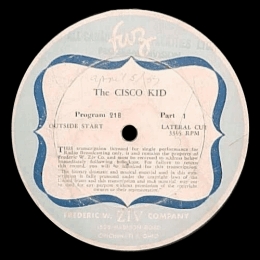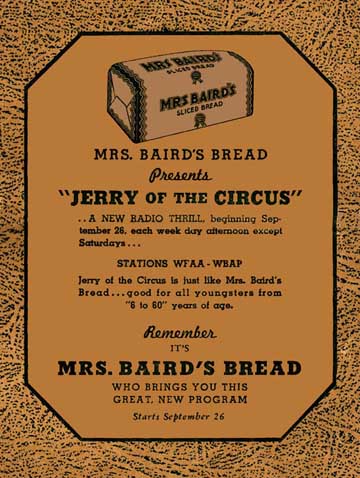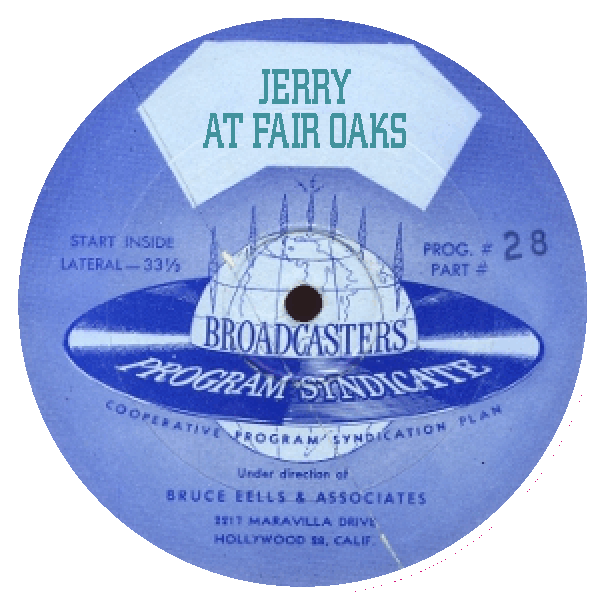

Back in the Golden age of Radio, tape recorders and other kinds of mass storage were not available. Cutting-edge technology in the 1930s and -40s was represented by records. In the earlier part of the era, programs were nearly always broadcast live, and many network shows had two separate performances for broadcast in different time zones. Later, many shows were recorded as "electrical transcriptions" and distributed to stations as records. These weren't the 10-inch, 78-rpm discs that are familiar even today (at least to some). In order to fit a 15- or 30-minute program on a single recording, the speed was slowed down to 33-1/3 rpm and the size of the platter was expanded to 16 inches, from the more usual 10 or 12 inches. This allowed for about 15 minutes of recording time per side.
Even if you have a working turntable, you still probably can't play these, for a couple of reasons. First, a special tonearm is required to accomodate the large size. These are pretty scarce but they can be had. Second, modern styli are designed to track the much smaller grooves that are found on the 45s and long-play 33-1/3 records that became the standard later. Using a modern stylus will sound awful and will likely damage the record. Luckily for those of us afflicted with the desire to collect these things, there are turntables and cartridges still made for just this purpose.
Surprisingly, a huge number of transcription records are still available. Many were made during and after World War II for play on Armed Forces Radio. There are also a large number of recordings that made up standard libraries for stations. A number of companies specialized in libraries of recordings. During the early 40s, there was a labor dispute that put a stop to a lot of commercial recorded musical output. For a time, radio transcriptions that were not released commercially were the only output from many artists.
Many transcriptions closely resemble commercial pressings, except for size. However, there are a lot of variations. Some are recorded only on one side, Some have the groove running from the inside of the record to the outside, rather than the more usual outside start. This was especially true for programs running longer than 15 minutes that required multiple sides. Often, side one had an outside start while side 2 would start from the inside. The reason was that the response characteristics for a recording would change subtly as the stylus moved from edge to center. (This is why some modern turntables have "linear tracking" tonearms.) By starting part 2 at the center, any noticeable differences were avoided.
Another difference between transcriptions and more modern records is in the materials used. While many transcription that turn up today look like a common vinyl disc, many are quite different. Before the war, it was common to press these records on discs made of aluminum, with a coat of shellac to hold the groove. Actually, I've seen some from the early 30s where the groove was cut directly into the aluminum. When war broke out, aluminum, became a strategic material and other materials were used. Glass often formed the base upon which shellac was sandwiched. These discs are pretty fragile and a lot of them didn't survive. even cardboard was used occasionally. I have quite a few that were pressed in translucent red or blue vinyl, in addition to the more ordinary black.
Recordings of drama, comedy, or variety programs seem to be much more rare than musical discs. I think this is because they were only meant to be played once then destroyed, or returned to the syndicator or network. The musical disks were meant to be saved and re-played. Some programs were saved, however and I have managed to snag a few, I actually have more than half the transcriptions from a couple of programs from the mid 1930s. Sone of these present interesting historical clues. The were apparently sold from station to station as acollection. I have several programs where the stations that acquired them second hand have noted their call letters on the label, along with the date of (re-)broadcast. Sometimes, several playings are indicated in this way.
Finally, transcriptions were used to record jingles, commercials, and even cuts of theme music to be used in local radio productions. Most of the full-blown recordings of commercial I've seen are from the 1950s and early 60s. In the earlier years, commercials were more likely to be read by the local or network announcer, sometimes with a recorded jingle incorporated. Below is an incomplete listing of my collection. Some of my recordings are currently in storage, so I've used dummy labels or other pictures for illustration purposes until I have a chance to scan the actual items.
 |
Jerry of the CircusJerry of the Circus was a well-made juvenile program produced and syndicated in 1937 by Bruce Eells and distributed by the Broadcasters Program Syndicate. Jerry Dugan is a young man whose father recently passed away. Knowing that his time was drawing near, Mr. Dugan wrote to his old friend Sam Randall, owner of The Randall Brothers' Circus, asking him to take care of Jerry. Jerry quickly becomes part of the circus community and many adventures follow. In all, 130 15-minute episodes were produced, of which all but two survive. You can listen to them here: Jerry of the Circus at the Internet Archive . While this is clearly aimed at a younger audience, it's quite enjoyable and the nostalgia factor is high. This was a popular program in its day. I found the following entry in one of the broadcasting trade papers from 1939. Sales That Speak Under caption, "Sales Tales", KSTP, St. Paul, has issued a promotion folder telling of the response to a test offer of a post card photograph in connection with the transcribed program Jerry of the Circus, sponsored by ZinsmasterBaking Co., that city. Folder reproduces a letter of recommendation from Harry W. Zinsmaster, president of the firm, and relates that only three spot announcements on this program brought in 2,023 requests from 79 counties in five States. Program is produced by Radio Transcription Co. of America, Hollywood.
I currently own the original transcriptions of the episodes listed below. They are on 16-inch transcription records, one episode per side: |
 |
Jerry at Fair OaksThe further adventures of Jerry Dugan. Sam Randall has paid for Jerry to get an education at Fair Oaks Military Academy. It's good fun of the kind we (and our children) just aren't exposed to anymore. This series was recorded in 1937 and 1938 by Bruce Eells and distributed by Broadcasters Program Syndicate. A total of 65 15-minute episodes were produced, all of which survive. You can listen to them here: Jerry at Fair Oaks at the Internet Archive . Like Jerry of the Circus, this series is fun to listen to. In fact, I enjoy this one more than its predecessor.
I own the original transcriptions of the episodes listed below: |
Love TalesPure soap opera. This series was recorded in 1936 and 1937 by Bruce Eells and distributed by Broadcasters Program Syndicate. As far as I can determine, 39 15-minute episodes were produced, all of which survive. I haven't found an online source for this program, with the exception of a couple of individual episodes.
I own most of the original transcriptions: |